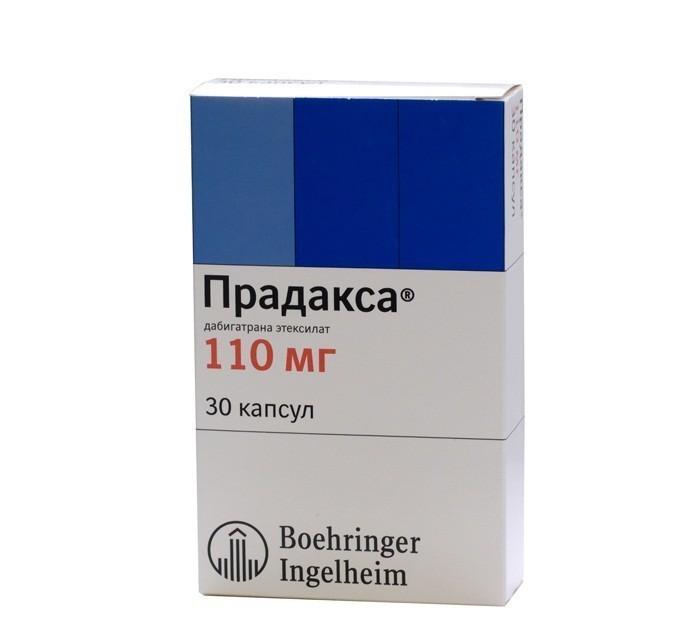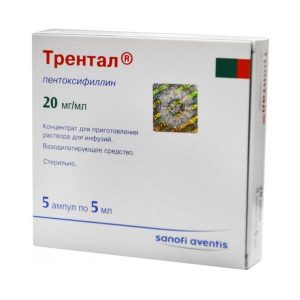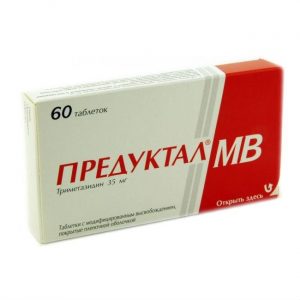Description
Latin name
PRADAXA
Release form
Capsules.
Packing
30 pcs
Pharmacological action
Mechanism of action. Dabigatran etexilate is a low molecular weight prodrug that does not exhibit pharmacological activity. After oral administration of dabigatran, etexilate is rapidly absorbed and is converted into dabigatran in plasma and liver by hydrolysis catalyzed by esterase. Dabigatran is a strong competitive reversible direct thrombin inhibitor and the main active substance in blood plasma.
Since thrombin (serine protease) activates the conversion of fibrinogen to fibrin in the blood coagulation system, its inhibition prevents the development of a blood clot. Dabigatran also inhibits free thrombin, fibrin-bound thrombin and thrombin-induced platelet aggregation.
Pharmacodynamic effect. There is a close correlation between the concentration of dabigatran in blood plasma and the degree of anticoagulant effect based on studies.
Dabigatran prolongs thrombin time (TB), blood coagulation time (BSC), and activated partial thromboplastin time (APTT).
A calibrated diluted thrombin time (rTB) test provides an approximate blood plasma concentration of dabigatran, which can be compared with the expected. VSK can provide a direct measurement of the activity of direct thrombin inhibitors. The APTT test is widespread and provides an approximate measure of the anticoagulation intensity achieved by dabigatran. However, the APTT test has limited sensitivity and is not suitable for accurately quantifying the anticoagulant effect, especially at high plasma concentrations of dabigatran. High APTT values should be interpreted with caution.
Pharmacokinetics. After oral administration of dabigatran, etexilate quickly and completely turns into dabigatran, which is an active form in blood plasma. The conversion of the prodrug of dabigatran etexilate by esterase-catalyzed hydrolysis to the active substance dabigatran is a dominant metabolic reaction. The absolute bioavailability of dabigatran after oral administration of dabigatran etexilate was about 6.5%.
After oral administration of dabigatran etexilate, the pharmacokinetic profile of dabigatran in blood plasma is characterized by a rapid increase in concentration with reaching Cmax 0.5–2 hours after administration.
Indications
Prevention of venous thromboembolism in patients after orthopedic surgery.
Contraindications
– severe renal failure (CC less than 30 ml / min)
– hemorrhagic disorders, hemorrhagic diathesis, spontaneous or pharmacologically induced hemostasis
– active clinically significant bleeding
– which can affect liver function and liver disease survival
– concomitant use of quinidine
– organ damage due to clinically significant bleeding, including hemorrhagic stroke within the previous 6 months before onset and
therapy – less than 18 years of age
– known hypersensitivity to dabigatran or dabigatran etexilate or to one of the excipients.
Cautions
risk of hemorrhage..: Unfractionated heparin can be used to maintain the functioning of a central venous or arterial catheter.
Should not be used simultaneously with the PRADAXAВ® preparation: unfractionated heparins or its derivatives, low molecular weight heparins, sodium fondaparinux, desirudin, thrombolytic agents, GPIIb / IIIa receptor antagonists, clopidogrel, ticlopidine, dextran, sulfinpyraxone VitraPhindAndraPhondAndronВ® AntagonВ® and AntonВ® ParatonВ® AnthonВ® and AntagonВ® ParatonВ® AnthonВ® and AntagonВ® ParatonВ® AnthonВ® and AntagonВ® ParatonВ® AntonPhardAndronВ® Antr in doses recommended for the treatment of deep vein thrombosis and acetylsalicylic acid in doses of 75-320 mg increases the risk of bleeding. Data indicating an increased risk of bleeding associated with dabigatran when taking PRADAXВ® in the recommended dose for patients, receiving small doses of acetylsalicylic acid in order to prevent cardiovascular disease, are absent. However, the available information is limited, therefore, with the combined use of low dose acetylsalicylic acid and PRADAXAВ®, it is necessary to monitor the condition of patients with the goal of
timely diagnosis of bleeding.
Careful monitoring (for symptoms of bleeding or anemia) should be carried out in cases in which there may be an increased risk of hemorrhagic complications: – A recent biopsy or trauma.
– The use of drugs that increase the risk of hemorrhagic complications. The combination of PRADAXAВ® with drugs that affect hemostasis or coagulation processes.
– Bacterial endocarditis
Short-term administration of NSAIDs when used together with PRADAXAВ® for analgesia after surgery does not increase the risk of bleeding. Limited data are available on the systematic administration of NSAIDs with a half-life of less than 12 hours in combination with PRADAXAВ®, there is no evidence of an increased risk of bleeding.
Renal failure: pharmacokinetic studies have shown that in patients with decreased renal function, including age-related, an increase in the effectiveness of the drug was noted. In patients with moderately reduced renal function (creatinine clearance of 50-30 ml / min), it is recommended to reduce the daily dose to 150 mg per day.patients should be monitored for the possible identification of neurological symptoms.
Effect on the ability to drive mechanisms
The effects of dabigatran etexilate on the ability to drive vehicles and drive mechanisms have not been studied.
Composition
Dabigatran etexilate mesylate
Excipients: acacia gum, coarse tartaric acid, tartaric acid powder, crystalline tartaric acid, hypromellose, dimethicone, talc, hyprolose (hydroxypropyl cellulose).
Dosage and administration
The drug is prescribed orally.
Adults for the prevention of venous thromboembolism (BT) in patients after orthopedic surgery, the recommended dose is 220 mg / day once (2 capsules of 110 mg).
In patients with moderate impaired renal function, the risk of bleeding is increased, the recommended dose is 150 mg / day once (2 caps. 75 mg each).
For the prevention of BT after knee replacement, treatment should begin 1-4 hours after completion of the operation with a dose of 110 mg, followed by a dose increase to 220 mg once for the next 10 days. If hemostasis is not achieved, treatment should be delayed. If treatment has not started on the day of surgery, therapy should be started with a dose of 220 mg / day once.
For the prevention of BT after hip replacement, treatment should be started 1-4 hours after surgery with a dose of 110 mg, followed by a dose increase to 220 mg / day, once for the next 28-35 days. If hemostasis is not achieved, treatment should be delayed. If treatment has not started on the day of surgery, therapy should be started with a dose of 220 mg / day once.
Patients with severe hepatic impairment (Child-Pugh class B and C) or with liver diseases that could affect survival, or with a more than 2-fold increase in hepatitis V, the liver enzymes were excluded from clinical trials. In this regard, the use of Pradaxa in this category of patients is not recommended.
Side effects of
In controlled studies, some patients received the drug at 150-220 mg / day., Part – less than 150 mg / day., Part – more than 220 mg / day.
Any bleeding is possible. Extensive bleeding is rare. The development of adverse reactions was similar to reactions in the case of enoxaparin sodium.
From the hematopoietic system: anemia, thrombocytopenia.
From the blood coagulation system: hematoma, bleeding wounds, nosebleeds, gastrointestinal bleeding, bleeding from the rectum, hemorrhoidal bleeding, skin hemorrhagic syndrome, hemarthrosis, hematuria.
From the digestive system: impaired liver function, increased activity of hepatic transaminases, hyperbilirubinemia.
From the laboratory side: decreased hemoglobin and hematocrit
Local reactions: bleeding from the injection site, bleeding from the injection site of the catheter.
Complications of procedures and surgical interventions: spotting from a wound, hematoma after procedures, bleeding after procedures, postoperative anemia, post-traumatic hematoma, bleeding after procedures, bleeding from the incision site, drainage after the procedure, drainage of the wound.
The frequency of adverse reactions observed with dabigatran etexilate did not go beyond the frequency range of adverse reactions that develop with the use of sodium enoxyparin.
Drug Interactions
The combined use of PRADAX® with drugs that affect hemostasis or coagulation processes, including vitamin K antagonists, can significantly increase the risk of bleeding.
Dabigatran etexilate and dabigatran are not metabolized by the P450 cytochrome system and do not affect human in vitro cytochrome P450 enzymes. Therefore, when combined with PRADAXA®, drug interactions are not expected.
Atorvastatin: When used together with atorvastatin, no interaction is observed.
Diclofenac: with the combined use of the pharmacokinetics of diclofenac and dabigatran etexilate does not change, indicating a slight interaction.
NSAIDs used for a short time to reduce pain after surgery did not increase the risk of bleeding.
There is limited experience with PRADAX® in combination with long-term systematic administration of non-steroidal anti-inflammatory drugs (NSAIDs), which requires careful monitoring of patients.
Digoxin: pharmacokinetic interaction of this combination was not detected.
Pantoprazole: AUC reduction of about 30% was found. In clinical studies, no effect of the combination of pantoprazole or other proton pump inhibitors and PRADAX® on the development of bleeding or pharmacological effects was revealed.
Ranitidine: when used together with PRADAX®, the degree of absorption of dabigatran does not change.
Transporter-level interactions: Amiodarone: with the combined use of PRADAX® and amiodarone, the rate and degree of absorption of the latter and the formation of its active metabolite desethylamiodarone do not change. AUC and Cmax increased by 60% and 50%, respectively.
With the combined use of dabigatran etexilate and amiodarone, it is necessary to reduce the dose of PRADAXA® to 150 mg per day. Due to the long half-life of amiodarone, the potential interaction of the drugs may persist for several weeks after canceling amiodarone.
P-glycoprotein inhibitors: Caution should be exercised when combined with PRADAXA® with active P-glycoprotein inhibitors such as verapamil, clarithromycin.
Repeated administration of verapamil over several days led to an increase in the concentration of dabigatran by 50-60%. This effect can be reduced by prescribing dabigatran at least two hours before taking verapamil.
Concomitant use of PRADAX® with quinidine is contraindicated.
P-glycoprotein inducers: Potential inducers such as rifampicin and St. John’s wort herb extract may reduce the effect of dabigatran. Caution should be exercised when sharing dabigatran with similar drugs.
With the combined use of dabigatran with antacids and drugs that inhibit gastric secretion, a change in the dose of dabigatran is not required.
No interaction of dabigatran with the most commonly used agents: opioid analgesics, diuretics, paracetamol, non-steroidal anti-inflammatory drugs, cyclooxygenase 2 inhibitors, hydroxymethylglutaryl-coenzyme A reductase inhibitors, lowering cholesterol / triglycerides (not related to statins), angiotensin II receptor blockers, ACE inhibitors, beta-adrenergic blockers, calcium channel blockers, prokinetics benzodiazepine derivatives.
Overdose
There is no antidote to dabigatran etexilate or dabigatran.
Using doses in excess of the recommended dose increases the risk of bleeding. In the event of bleeding, treatment should be suspended to determine the cause of the bleeding. Given the major route of excretion of dabigatran through the kidneys, it is recommended to provide adequate diuresis. If necessary, surgical hemostasis or transfusion of fresh frozen
plasma is possible.
Dabigatran is removed by dialysis but there is no clinical experience with this method.
Storage Conditions
At a temperature not exceeding 25C.
Shelf life
3 years.
Dosage form
capsule
Appointment
Appointment
Adults doctor’s prescription
Beringer Ingelheim, Austria




